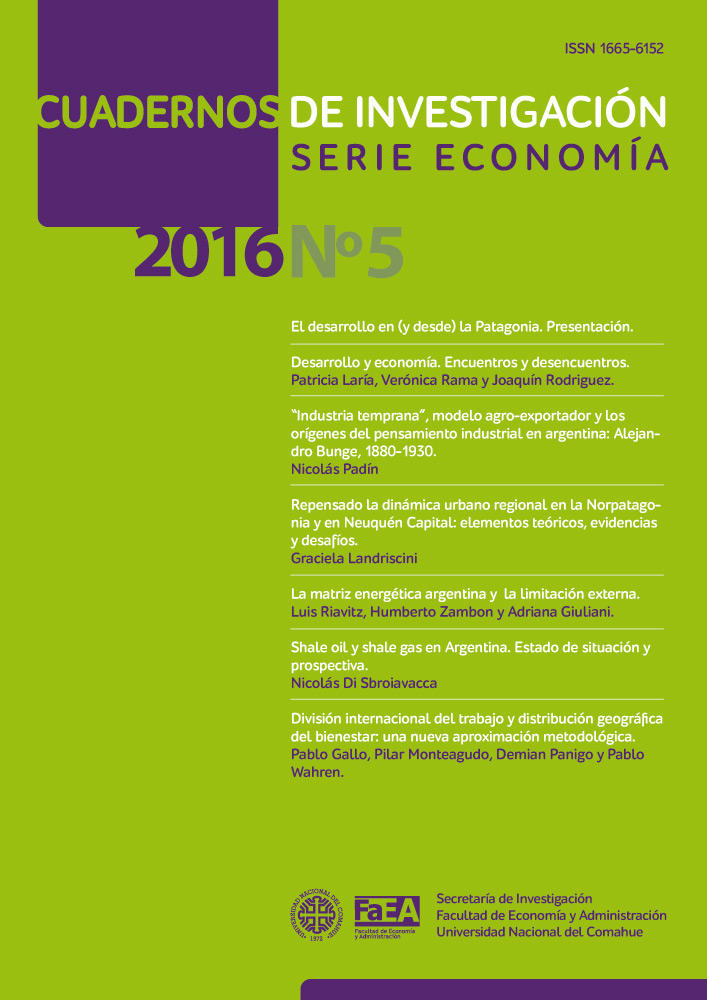Shale Oil Y Shale Gas in Argentina Current situation and foresight
Keywords:
Shale oil, shale gas, resources, reserves, scenariosAbstract
The production of oil and natural gas in Argentina has been declining since 1998 and2005 respectively. Given this situation and facing a sustained growth of energy demand, the country has become an importer of natural gas and oil products. Recent international publications indicate that Argentina would have 802 Tcf of technically recoverable unproved shale gas resources (equivalent to 21,654 billion m3) and 27,000 million barrels of shale oil (equivalent to 4.293 million m3). These would represent respectively 67 and 11 times the current proven reserves of conventional hydrocarbons. This information has installed high expectations for the future development of these resources, and is presented as the solution to the current problems of hydrocarbons shortage. In the present work the latest information on resources and reserves has been systematized and analyzed, and prospective exploratory scenarios on oil and natural gas supply and demand are presented. Based on this analysis it is concluded that the development of unconventional oil and natural gas is feasible, but this requires more information based on local data, which will provide better and more reliable estimates of volumes of recoverable hydrocarbons, initial well productivity, extraction and decline rates, well water production, potential environmental impacts, among other aspects, allowing to generate more knowledge on the management of this resource. According to the scenarios, a period of at least 5 to 10 years will be required to recover self- sufficiency based only on unconventional resources, thus diversifying the expansion of hydrocarbons supply in order to avoid depending exclusively on unconventional
resources is one of the ways forward.
Downloads
References
D. KOKOGIAN. (2010). “Perspectivas exploratorias de la plataforma continental argentina”. Revista Petrotecnia. Año LI No 5.
D. ROGERS (2013). “Shale and Wall Street: Was the decline in natural gas prices orchested?”. Energy Policy Forum.
ENERGY INFORMATION ADMINISTRATION (2011). “World Shale Gas Resources: An initial assessment of 14 regions outside United States”.
ENERGY INFORMATION ADMINISTRATION – ARI (2013). “World Shale Gas and Shale Oil Resources assessment”.
H. GIAMPAOLI (2012). “Vaca Muerta: Dos años de shale en Argentina. Análisis estadístico de producción a noviembre de 2012”. Revista Petrotecnia.
N. GUTIERREZ SCHMIDT, J. ALONSO Y A. GIUSIANO (2013). “Subsecretaría de Minería e Hidrocarburos. Dirección de Estudios, Provincia de Neuquén Evaluación del Shale Oil de la Formación Vaca Muerta. Análisis de la declinación de la producción”. Revista Petrotecnia.
NEWSLETTER DIARIO INVERSOR ENERGÉTICO Y MINERO (2013). “YPF confía en aumentar 30% su producción de petróleo con Vaca Muerta”.
US. GEOLOGICAL SURVEY (2000). “USGS Model for Undiscoverd for conventional oil, gas and NGL Resources – Seventh Approximation”.
Downloads
Published
How to Cite
Issue
Section
License
Licencia: Compartir - copiar y redistribuir el material en cualquier medio o formato.
La licenciante no puede revocar estas libertades en tanto usted siga los términos de la licencia.
https://creativecommons.org/licenses/by-nc-nd/2.5/ar/






